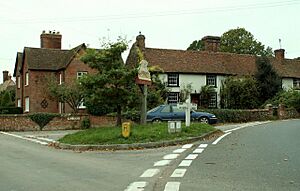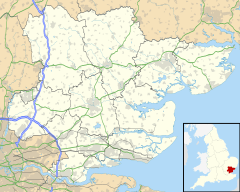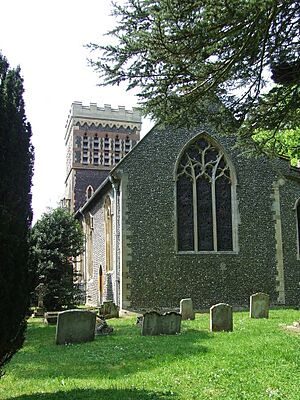Foxearth facts for kids
Quick facts for kids Foxearth |
|
|---|---|
 Foxearth village sign |
|
| Population | 296 (Including Liston 2011 Census) |
| District |
|
| Shire county | |
| Region | |
| Country | England |
| Sovereign state | United Kingdom |
| Post town | SUDBURY |
| Postcode district | CO10 |
| Dialling code | 01787 |
| Police | Essex |
| Fire | Essex |
| Ambulance | East of England |
| EU Parliament | East of England |
Foxearth is a small village and civil parish located right on the edge of north Essex and Suffolk in England. It sits between the villages of Long Melford and Cavendish. Its neighbours include Borley, Belchamp Walter, Belchamp Otten, Liston, and Pentlow. In 2001, about 303 people lived in the parish.
Contents
The History of Foxearth
Foxearth is a very old settlement in northern Essex. The area around the village is about 7 miles (11 km) around. It is 3 miles (5 km) from Sudbury, 7 miles (11 km) from Halstead, and 56 miles (90 km) from London. The land here has very good soil, which is a mix of clay and loam.
Foxearth has always been a farming village. It even had its own watermill. This mill was originally in a separate area called Weston. But in 1286, Weston and Foxearth joined together.
Early Days and the Domesday Book
Long ago, during the time of Edward the Confessor, the village was owned by 19 "sochmen" and 4 "freemen." Sochmen were like free farmers who owned their land but had some duties to a lord. Freemen were people who had more rights and freedoms.
The Domesday Book was a huge survey of England ordered by William the Conqueror in 1086. It showed that the small area of Foxearth Hall became the property of Richard Fitz-Gilbert. He was an ancestor of the lords of Clare.
What's in a Name?
The name "Foxearth" literally means "fox's den." The village was recorded as "Focsearde" in the Domesday Book. Over the years, its spelling changed many times. Some old spellings include Foxherde (1202), Foxherthe (1232), and Foxhole (1212). Finally, by 1594, it was known as Foxearth.
A Changing Village: The Brewery Era
Until the mid-1800s, Foxearth was a typical farming village. But then, a wealthy vicar named Rev. John Foster changed things. He wanted to help the villagers find other jobs besides farming.
In 1878, Rev. Foster paid for a brewery to be built in the village. This brewery gave people new work opportunities. The Ward family ran the brewery for three generations. Because of the Wards, many of the village buildings were rebuilt using red brick and flint stone walls.
The brewery was one of the first to make bottled beers. It also made several non-alcoholic bottled drinks. In 1957, the brewery was sold to Taylor Walker & Co. The very last batch of beer was made on February 19, 1958.
The brewery was bought back by the Ward family in 1960. However, they sold it again in 1963 to Charrington United Breweries. The brewery site was sold in 1988, and the building was torn down in the 1990s. Today, houses stand where the brewery once was.
St. Peter and St. Paul's Church
The village church, called St. Peter and St. Paul's, is on the east side of Foxearth. Its walls are made of flint stones with stone decorations. The roofs are covered with tile and lead.
The church has a tower, a main area called the nave, and a north aisle (a side section). It used to have a south aisle too. There is also a chancel, which is the part of the church where the altar is. Next to the chancel is Kemp's Chapel, which belongs to the nearby hall.
The whole church building is made of stone. At the west end, there is a square tower. This tower used to have a spire (a tall, pointed roof) and eight bells. Today, the bells are silent, except for the automatic clock chimes.
The nave of the church is very old, but its exact age is not known. Around 1350, a north aisle was added, and the chancel was rebuilt. The north aisle was rebuilt and made wider around 1450. Kemp's Chapel was also added around this time.
The west tower was added in 1862 by Rev. John Foster, the same vicar who helped build the brewery. The church was also repaired and a south porch was added around the same time.
The chancel is about 29 feet (8.8 m) long and 18 feet (5.5 m) wide. It has a window from around 1350. This window has three ogee lights (pointed arches) with leaf designs. The church also has other windows and doorways from different periods, including the 15th century and the Victorian era. There is no arch separating the chancel from the nave. Instead, there is a wooden beam, likely from the 15th century.



